The assignment we were given sounded relatively simple.
Mail & Guardian photographer Lisa Skinner and I were to drive from Durban to George over the course of six days, visiting six different tourism products that have been the subject of a groundbreaking development partnership between Fair Trade in Tourism South Africa (FTTSA) and the National Development Agency.
After picking up our little Tata Indica in Durban and sharing some misgivings about how well this car would handle the Transkei’s infamous roads, we remembered that a hired car is always the best 4×4, loaded it up and hit the road.
First up was Masakala Traditional Guesthouse close to Matatiele in KwaZulu-Natal’s southern Drakensberg, near the border with Lesotho. As we passed Kokstad, snow-capped peaks gave us an indication that our destination was close at hand. A winding road led through the village of Masakala, named for the mountain beneath which it nestles, to a charming and very rural guesthouse.
 Sarah Shasha (Photo: Lisa Skinner) We were greeted by Robert Mnika and Sarah Shasha, our hosts. Mnika, an amiable and softly spoken man with an almost encyclopaedic knowledge of the area, explained that the guesthouse and the Mehloding Adventure Trail — which is also run by the community — came out of a realisation by the community that action was required to solve poverty in the village. Two areas were identified, tourism and agriculture. Tourism was the first to get up and running.
Sarah Shasha (Photo: Lisa Skinner) We were greeted by Robert Mnika and Sarah Shasha, our hosts. Mnika, an amiable and softly spoken man with an almost encyclopaedic knowledge of the area, explained that the guesthouse and the Mehloding Adventure Trail — which is also run by the community — came out of a realisation by the community that action was required to solve poverty in the village. Two areas were identified, tourism and agriculture. Tourism was the first to get up and running.
After sourcing funding, the community embarked on the two prongs of its plan: the Masakala Guesthouse and the Mehloding Adventure Trail. After lunch we followed Mnika on a village tour that involved scaling the mountain (more of a hill in reality) and surveying Masakala village from on high. The village is built around the base of the mountain, a tradition he told us that comes from the time the local Baphuti people lived in Lesotho and learned from the Basotho that it was a lot easier to defend a village by standing above it and tossing rocks down on the attackers than by other techniques.
Attacking marauders is, apparently, a less common phenomenon nowadays, though Mnika did tell us that stock theft is something they have to contend with on a regular basis, leading to a reduction in the number of cattle held in the village. If nothing else, our visi t to Masakala showed us the power of true community involvement in responsible tourism. The trail and the guesthouse provide employment for about 40 people, involved as guides or in the construction or maintenance of the trail, which itself has four chalets.
The money that the trail and the guesthouse make is put into a community trust and the community decides how best to use it. On the village tour we got the distinct feeling that the entire community was behind the project. In this village the mountain air is fresh and the welcome warm.
After breakfast the next morning, we set off for Lusikisiki in the Eastern Cape, where we were to meet Peter Retallick at the Sasol garage to leave our car and venture off the beaten track to the Drifters Luphuthana Lodge on the coast. The lodge is one of a chain of six camps and lodges that run from Msikaba in the north to Port St Johns in the south along some of the most beautiful coastline that South Africa has to offer.
Retallick said the lodges were built as part of a community upliftment project with the help of the European Union and that after their completion, Drifters was awarded the right to manage the facilities in conjunction with the local communities. In addition to contributing to the communities along the coast, the lodges also provide vital employment for communities that are too far from the local centres to make commuting a viable option.
You have the option of going on a village tour, getting a local guide or ensuring that someone gets your backpack to the next camp, making your hike a more pleasant experience. The Drifters experience is very different from Masakala in that you get to take in the natural splendour of the Wild Coast while making sure the people who live there have the chance of a better life.
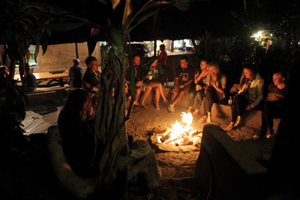 Coffee Shack (Photo: Lisa Skinner) After a bumpy ride to Lusikisiki, we set course for Mthatha and then Coffee Bay. Our destination for the night was the Coffee Shack, a stalwart of the area’s tourism establishments. As we pulled in, Skinner commented that she felt as though she was back at varsity, only now older and more “boring”. The Coffee Shack is one of those amazing backpacker destinations that young people from all over the world seem magnetically attracted to. Sitting outside the bar on a sunny afternoon, we heard a greater range of accents than you found in Sandton during the Fifa World Cup. But, despite its laid-back attitude, the Coffee Shack does not sit outside its environment.
Coffee Shack (Photo: Lisa Skinner) After a bumpy ride to Lusikisiki, we set course for Mthatha and then Coffee Bay. Our destination for the night was the Coffee Shack, a stalwart of the area’s tourism establishments. As we pulled in, Skinner commented that she felt as though she was back at varsity, only now older and more “boring”. The Coffee Shack is one of those amazing backpacker destinations that young people from all over the world seem magnetically attracted to. Sitting outside the bar on a sunny afternoon, we heard a greater range of accents than you found in Sandton during the Fifa World Cup. But, despite its laid-back attitude, the Coffee Shack does not sit outside its environment.
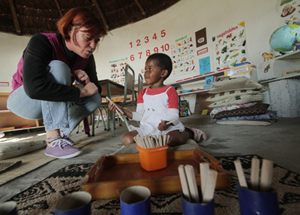 Dawn Brochenin (Photo: Lisa Skinner) Dawn Brochenin, who runs the community programmes and used to manage the Coffee Shack, said that not only does the local community own 30% of the establishment, the profit from which goes into its trust, there is also an active effort to get visitors involved in supporting its education initiatives. In our rooms were countless notices telling us how we could get involved in helping the local community, from buying chairs and desks for the local primary school to helping local kids go to boarding school. Some visitors have even become involved in paying for a community member to attend university. Visitors have contributed to the pre-primary school overlooking Coffee Bay, which Brochenin runs.
Dawn Brochenin (Photo: Lisa Skinner) Dawn Brochenin, who runs the community programmes and used to manage the Coffee Shack, said that not only does the local community own 30% of the establishment, the profit from which goes into its trust, there is also an active effort to get visitors involved in supporting its education initiatives. In our rooms were countless notices telling us how we could get involved in helping the local community, from buying chairs and desks for the local primary school to helping local kids go to boarding school. Some visitors have even become involved in paying for a community member to attend university. Visitors have contributed to the pre-primary school overlooking Coffee Bay, which Brochenin runs.
The next morning we trekked up the hill to visit the school where 11 kids get a foundation that should stand them in good stead. There was no time for dallying in the early spring sunshine and soon we were heading off to our next destination, Bulungula. There is no simple way to get to Bulungula and, depending on the road conditions, you may need to call for a lift from the nearby store. Luckily, we managed to get our car all the way down to the lodge. There are places in the world that you know from the moment you arrive are special. Bulungula is one of them.
Dave Martin, the brains behind the operation, met us as we stepped out of the car and took us on a tour of the lodge. Everything at Bulungula seems to be focused on preserving the environment and integrating the community. When you hear comments like: “The doors don’t lock because they don’t need to,” a big city boy like me would normally do a double take, but down there it is the simple truth.
The lodge and the community are not two separate entities; they are one and the same and it’s not unusual to see locals hanging out at the lodge and drinking at the bar. Martin, his wife, Rejane Woodroffe, and his mother, Annette Champion, live in the Nqileni village. Champion runs the early-learning centre. When I mention that I have seen worse-equipped preschools in the posh parts of the northern suburbs of Jo’burg, I am not exaggerating.
It is impossible to describe what has been achieved in a part of the country where there is no mains electricity. If a model was created on how to do tourism right, in complete harmony with the community, Bulungula would probably be a good place to start. Check it out at www.bulungulaincubator.wordpress.com. After four days on the road we would have loved to have spent a day lounging on the beach at Bulungula.
In fact I could have spent a month there. But the road was calling and we headed inland, up dirt roads and finally on to the road that runs from the N2 to Coffee Bay. Although this road is in the process of being upgraded, it bears mentioning that everyone on the Coffee Bay road drives as though they are on hallucinogenics. Luckily, they are not stoned, just dodging the potholes.
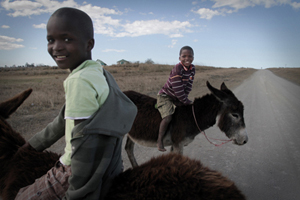 homestay (Photo: Lisa Skinner) We headed out of the old Transkei through East London on the way to Grahamstown, Skinner’s old varsity haunt. Hooking up with Buyiswa Gora at the Makana Tourism Office, we drove up to Joza township to stay the night and take a look at a number of the “homestays” that form part of the Kwam eMakana Homestays Association. The association operates almost exclusively during the National Arts Festival in July each year, but some of the women opened their homes to show us what guests normally experience.
homestay (Photo: Lisa Skinner) We headed out of the old Transkei through East London on the way to Grahamstown, Skinner’s old varsity haunt. Hooking up with Buyiswa Gora at the Makana Tourism Office, we drove up to Joza township to stay the night and take a look at a number of the “homestays” that form part of the Kwam eMakana Homestays Association. The association operates almost exclusively during the National Arts Festival in July each year, but some of the women opened their homes to show us what guests normally experience.
Most of the women who run the homestays are unemployed and they rely on the income from tourism to provide for their families. Some have upgraded their houses to ensure that they get a better grading from the association. Each homestay is receives either an A, B or C grading.
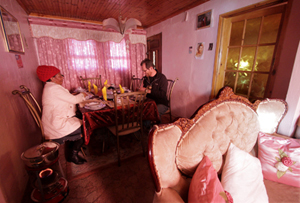 Lizeka Titi (Photo: Lisa Skinner) Lizeka Titi’s house, where we spent the night, was A-graded and she had clearly taken a great deal of care to ensure that her house was immaculate. Joza township is not the quietest place to spend the night; the neighbourhood dogs decided to put on an impromptu concert for us. But as a real urban experience, Liseka’s house was a treat. After the long trek from Bulungula to Grahamstown (it took us about seven hours) the previous day, the four-hour drive to Knysna the next morning was a joyous celebration of well-maintained roads with no potholes.
Lizeka Titi (Photo: Lisa Skinner) Lizeka Titi’s house, where we spent the night, was A-graded and she had clearly taken a great deal of care to ensure that her house was immaculate. Joza township is not the quietest place to spend the night; the neighbourhood dogs decided to put on an impromptu concert for us. But as a real urban experience, Liseka’s house was a treat. After the long trek from Bulungula to Grahamstown (it took us about seven hours) the previous day, the four-hour drive to Knysna the next morning was a joyous celebration of well-maintained roads with no potholes.
I even managed to smile at the toll-booth attendants as we passed through. After meeting Glendyrr Fick at the Knysna Tourism office and being given our assignments for the day, we headed off to the Old Goal complex to check out the Muse Factory, a collective of local women who produce great beadwork, which they sell from the small office next to the Knysna Art Gallery and to local companies and organisations.
Then we moved quickly along to the homestay where we were to spend the night, part of the Mothers of Creation rural tourism route, a collection of 11 homestays scattered across the southern Cape, including the Garden Route and the Karoo. After checking in, we visited Judah Square, the site of the largest Rastafarian community in South Africa and one of the other homestays on the Mothers of Creation route.
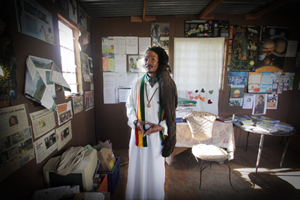
Brother Zeb (Photo: Lisa Skinner) Brother Zeb, who was our guide, said that, despite the negative perception of Rastafarians held by some people, they had been welcomed by the local community. Their 30-strong members were now an integral part of the local community. In addition to bringing visitors to the community, they also run a pre-school. After stopping at Mama B’s house — a Jamaican import and cornerstone of the local Rastafarian community — we returned to the homestay. The Bethany Homestay, run by Magda Kock, overlooks Hornlee township.
After raising five children, she knows how to take care of her guests. And, as with the other homestays, Bethany Homestay delivers value directly to the community that it serves. We said goodbye to Kock, loaded our (now very dusty) car for the last time, pulled out of the driveway and headed for George, the airport and home. It was a hurried trip. But what became clear is that when a community feels it owns a project, the people feel the benefit of it. The greater the involvement of the community, the greater the benefit for everyone involved. It is a lesson the entire tourism industry can learn.